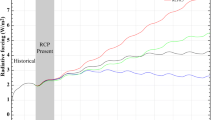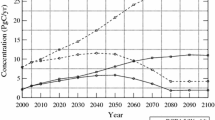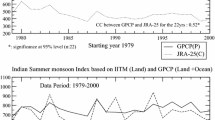Abstract
Global climate model (GCM) simulations driven by various emission scenarios are widely used for the projections of future climate change. In this study, an assessment was carried out by using 35 GCMs under Coupled Model Intercomparison Project (CMIP5) in reproducing the present day wind speed changes over six selected regions in the Indian Ocean region based on altimetry-measured merged wind speed product in the Indian Ocean. The relative ranking of the GCMs is performed based on the evaluation of the CMIP5 historical simulations for the period 1993–2005. The skill level of GCMs in representing the various metrics such as annual mean, mean seasonal cycle, linear trend, correlation coefficient, and seasonal standard deviations was accounted for the relative ranking of the GCMs. The models CMCC-CESM, HadGEM2-ES, and GFDL-ESM2G are found to be better for the Arabian Sea region. The GCM products such as HadCM3, CSIRO-Mk3.6.0, HadGEM2-CC, HadGEM2-AO, and MIROC5 were noticed better for the Bay of Bengal (BoB) region. Large bias in wind speed (~ 3 m/s) is observed for the head BoB and the Southern Ocean region. Bias corrections for the present-day Representative Concentration Pathway (RCP) simulations (2006–2016) were performed based on quantile mapping (QM) method, and the present-day wind changes are also compared with observations. The findings from study recommend that suitable bias correction for different GCMs is an essential pre-requisite for climate change studies.



Similar content being viewed by others
References
Anav, A., Friedlingstein, P., Kidston, M., Bopp, L., Ciais, P., Cox, P., Jones, C., Jung, M., Myneni, R., & Zhu, Z. (2013). Evaluating the land and ocean components of the global carbon cycle in the CMIP5 Earth System Models. Journal of Climate, 26(18), 6801–6843.
Bhaskaran, P., Gupta, N., & Dash, M. (2014). Wind-wave climate projections for the Indian Ocean from satellite observations. Journal of Marine Science: Research & Development, 11, 005.
Bracegirdle, T. J., Hyder, P., & Holmes, C. R. (2018). CMIP5 diversity in southern westerly jet projections related to historical sea ice area: strong link to strengthening and weak link to shift. Journal of Climate, 31(1), 195–211.
Brekke, L. D., Dettinger, M. D., Maurer, E. P., & Anderson, M. (2008). Significance of model credibility in estimating climate projection distributions for regional hydroclimatological risk assessments. Climatic Change, 89(3-4), 371–394.
Cannon, A. J., Sobie, S. R., & Murdock, T. Q. (2015). Bias correction of GCM precipitation by quantile mapping: how well do methods preserve changes in quantiles and extremes? Journal of Climate, 28(17), 6938–6959.
Casas-Prat, M., Wang, X., & Swart, N. (2018). CMIP5-based global wave climate projections including the entire Arctic Ocean. Ocean Modelling, 123, 66–85.
Chelton, D. B., & McCabe, P. J. (1985). A review of satellite altimeter measurement of sea surface wind speed: with a proposed new algorithm. Journal of Geophysical Research: Oceans, 90, 4707–4720.
Chu, J.-E., Ha, K.-J., Lee, J.-Y., Wang, B., Kim, B.-H., & Chung, C. E. (2014). Future change of the Indian Ocean basin-wide and dipole modes in the CMIP5. Climate Dynamics, 43(1-2), 535–551.
Clarke, L., Edmonds, J., Jacoby, H., Pitcher, H., Reilly, J., & Richels, R. (2007). Scenarios of greenhouse gas emissions and atmospheric concentrations. US Department of Energy Publications, 6.
De Souza, K., Kituyi, E., Harvey, B., Leone, M., Murali, K. S., & Ford J. D. (2015). Vulnerability to climate change in three hot spots in Africa and Asia: key issues for policy-relevant adaptation and resilience-building research, edited, Springer.
Deng, X., Featherstone, W., Hwang, C., & Shum, C. (2001) Improved coastal marine gravity anomalies in the Taiwan Strait from altimeter waveform re-tracking. In Proceedings of the International Workshop on Satellite Altimetry for Geodesy, Geophysics and Oceanography.
Deng, X., Featherstone, W., Hwang, C., & Berry, P. (2002). Estimation of contamination of ERS-2 and POSEIDON satellite radar altimetry close to the coasts of Australia. Marine Geodesy, 25, 249–271.
Dobrynin, M., Murawsky, J., & Yang, S. (2012). Evolution of the global wind wave climate in CMIP5 experiments. Geophysical Research Letters, 39.
Erikson, L. H., Hegermiller, C., Barnard, P., Ruggiero, P., & van Ormondt, M. (2015). Projected wave conditions in the Eastern North Pacific under the influence of two CMIP5 climate scenarios. Ocean Modelling, 96, 171–185.
Frankcombe, L. M., Spence, P., Hogg, A. M., England, M. H., & Griffies, S. M. (2013). Sea level changes forced by Southern Ocean winds. Geophysical Research Letters, 40(21), 5710–5715.
Fu, L.-L., Chelton, D. B., & Zlotnicki, V. (1988). Satellite altimetry: observing ocean variability from space. Oceanography, 1, 4–58.
Fujino, J., Nair, R., Kainuma, M., Masui, T., & Matsuoka, Y. (2006). Multi-gas mitigation analysis on stabilization scenarios using AIM global model. The Energy Journal, 343–353.
Glazman, R. E., & Greysukh, A. (1993). Satellite altimeter measurements of surface wind. Journal of Geophysical Research: Oceans, 98, 2475–2483.
Gleckler, P. J., Taylor, K. E., & Doutriaux, C. (2008). Performance metrics for climate models. Journal of Geophysical Research-Atmospheres, 113(D6).
Gleckler, P., Ferraro, R., & Waliser, D. (2011). Improving use of satellite data in evaluating climate models, Eos. Transactions of the American Geophysical Union, 92(20), 172–172.
Gupta, N., Bhaskaran, P. K., & Dash, M. K. (2015). Recent trends in wind-wave climate for the Indian Ocean. Current Science, 108(12), 2191–2201.
Gupta, N., Bhaskaran, P. K., & Dash, M. K. (2017). Dipole behaviour in maximum significant wave height over the Southern Indian Ocean. International Journal of Climatology, 37, 4925–4937. https://doi.org/10.1002/joc.5133.
Hemer, M. A., & Trenham, C. E. (2016). Evaluation of a CMIP5 derived dynamical global wind wave climate model ensemble. Ocean Modelling, 103, 190–203.
Hemer, M., Church, J., Swail, V., & Wang, X. (2006). Coordinated global wave climate projections. Atmosphere-Ocean Interactions, 2, 185–218.
Hemer, M. A., Fan, Y., Mori, N., Semedo, A., & Wang, X. L. (2013). Projected changes in wave climate from a multi-model ensemble. Nature Climate Change, 3(5), 471–476.
Hijioka, Y., Matsuoka, Y., Nishimoto, H., Masui, T., & Kainuma, M. (2008). Global GHG emission scenarios under GHG concentration stabilization targets. Journal of Global Environment Engineering, 13, 97–108.
Intergovernmental Panel on Climate Change (IPCC). (2013). In T. F. Stocker et al. (Eds.), Climate Change 2013: The physical science basis, in the Fifth Assessment Report of the Intergovernmental Panel on Climate Change (pp. 161–162). Cambridge: Cambridge University Press.
Jayasankar, C., Surendran, S., & Rajendran, K. (2015). Robust signals of future projections of Indian summer monsoon rainfall by IPCC AR5 climate models: role of seasonal cycle and interannual variability. Geophysical Research Letters, 42(9), 3513–3520.
Joseph, R., & Nigam, S. (2006). ENSO evolution and teleconnections in IPCC’s twentieth-century climate simulations: realistic representation? Journal of Climate, 19(17), 4360–4377.
Kulkarni, S., Deo, M., & Ghosh, S. (2014). Changes in the design and operational wind due to climate change at the Indian offshore sites. Marine Structures, 37, 33–53.
Kulkarni, S., Deo, M., & Ghosh, S. (2018). Framework for assessment of climate change impact on offshore wind energy. Meteorological Applications, 25(1), 94–104.
Lee, J.-Y., & Wang, B. (2014). Future change of global monsoon in the CMIP5. Climate Dynamics, 42(1-2), 101–119.
Li, H., Sheffield, J., & Wood, E. F. (2010). Bias correction of monthly precipitation and temperature fields from Intergovernmental Panel on Climate Change AR4 models using equidistant quantile matching. Journal of Geophysical Research-Atmospheres, 115(D10).
Li, M., Liu, J., Wang, Z., Wang, H., Zhang, Z., Zhang, L., & Yang, Q. (2013). Assessment of sea surface wind from NWP reanalyses and satellites in the Southern Ocean. Journal of Atmospheric and Oceanic Technology, 30(8), 1842–1853.
Lutz, A. F., terMaat, H. W., Biemans, H., Shrestha, A. B., Wester, P., & Immerzeel, W. W. (2016). Selecting representative climate models for climate change impact studies: an advanced envelope-based selection approach. International Journal of Climatology, 36(12), 3988–4005.
Meehl, G. A., Arblaster, J. M., & Tebaldi, C. (2005). Understanding future patterns of increased precipitation intensity in climate model simulations. Geophysical Research Letters, 32(18).
Meinshausen, M., Smith, S. J., Calvin, K., Daniel, J. S., Kainuma, M., Lamarque, J.-F., Matsumoto, K., Montzka, S., Raper, S., & Riahi, K. (2011). The RCP greenhouse gas concentrations and their extensions from 1765 to 2300. Climatic Change, 109(1-2), 213–241.
Miller, R. L., Schmidt, G. A., Nazarenko, L. S., Tausnev, N., Bauer, S. E., DelGenio, A. D., Kelley, M., Lo, K. K., Ruedy, R., & Shindell, D. T. (2014). CMIP5 historical simulations (1850–2012) with GISS ModelE2. Journal of Advances in Modeling Earth Systems, 6(2), 441–478.
Mo, K. C., Long, L. N., & Schemm, J.-K. E. (2012). Characteristics of drought and persistent wet spells over the United States in the atmosphere–land–ocean coupled model experiments. Earth Interactions, 16(9), 1–26.
Mori, N., Yasuda, T., Mase, H., Tom, T., & Oku, Y. (2010). Projection of extreme wave climate change under global warming. Hydrological Research Letters, 4, 15–19.
Moss, R. H., Edmonds, J. A., Hibbard, K. A., Manning, M. R., Rose, S. K., Van Vuuren, D. P., Carter, T. R., Emori, S., Kainuma, M., & Kram, T. (2010). The next generation of scenarios for climate change research and assessment. Nature, 463(7282), 747–756.
Mote, P. W., & Salathe, E. P. (2010). Future climate in the Pacific Northwest. Climatic Change, 102(1-2), 29–50.
Nepal, S., & Shrestha, A. B. (2015). Impact of climate change on the hydrological regime of the Indus, Ganges and Brahmaputra river basins: a review of the literature. International Journal of Water Resources Development, 31(2), 201–218.
Panofsky, H. A. L. L., & Brier, G. W. (1968). Some applications of statistics to meteorology, Earth and Mineral Sciences Continuing Education, College of Earth and Mineral Sciences.
Parvathi, V., Suresh, I., Lengaigne, M., Izumo, T., & Vialard, J. (2017). Robust projected weakening of winter monsoon winds over the Arabian Sea under climate change. Geophysical Research Letters, 44(19), 9833–9843.
Patra, A., & Bhaskaran, P. K. (2017). Temporal variability in wind–wave climate and its validation with ESSO-NIOT wave atlas for the head Bay of Bengal. Climate Dynamics, 49(4), 1271–1288.
Pierce, D. W., Barnett, T. P., Fetzer, E. J., & Gleckler, P. J. (2006). Three-dimensional tropospheric water vapor in coupled climate models compared with observations from the AIRS satellite system. Geophysical Research Letters, 33(21).
Pierce, D. W., Barnett, T. P., Santer, B. D., & Gleckler, P. J. (2009). Selecting global climate models for regional climate change studies. Proceedings of the National Academy of Sciences, 106(21), 8441–8446.
Riahi, K., Grübler, A., & Nakicenovic, N. (2007). Scenarios of long-term socio-economic and environmental development under climate stabilization. Technological Forecasting and Social Change, 74(7), 887–935.
Riahi, K., Rao, S., Krey, V., Cho, C., Chirkov, V., Fischer, G., Kindermann, G., Nakicenovic, N., & Rafaj, P. (2011). RCP 8.5—A scenario of comparatively high greenhouse gas emissions. Climatic Change, 109(1-2), 33.
Roesler, C. J., Emery, W., & Kim, S. Y. (2013). Evaluating the use of high-frequency radar coastal currents to correct satellite altimetry. Journal of Geophysical Research: Oceans, 118, 3240–3259.
Roshin, E., & Deo, M. (2017). Derivation of design waves along the Indian coastline incorporating climate change. Journal of Marine Science and Technology, 22(1), 61–70.
Rosmorduc, V., Benveniste, J., Picot, N., & Niemeijer, S. (2010) Basic radar altimetry toolbox & tutorial, paper presented at Proc.‘ESA Living Planet Symposium’, Bergen, Norway.
Rosmorduc, V., Benveniste, J., Lauret, O., Maheu, C., Milagro, M., & Picot, N. (2018) Radar altimetry tutorial ESA, Europe:112-128.
Rupp, D. E., Abatzoglou, J. T., Hegewisch, K. C., & Mote, P. W. (2013). Evaluation of CMIP5 20th century climate simulations for the Pacific Northwest USA. Journal of Geophysical Research-Atmospheres, 118(19), 10,884–10,906.
Sabique, L., Annapurnaiah, K., Nair, T. B., & Srinivas, K. (2012). Contribution of Southern Indian Ocean swells on the wave heights in the Northern Indian Ocean—a modeling study. Ocean Engineering, 43, 113–120.
Scherrer, S. C. (2011). Present-day interannual variability of surface climate in CMIP3 models and its relation to future warming. International Journal of Climatology, 31(10), 1518–1529.
Schneider, B., Bopp, L., Gehlen, M., Segschneider, J., Frölicher, T., Cadule, P., Friedlingstein, P., Doney, S. C., Behrenfeld, M. J., & Joos, F. (2008). Climate-induced interannual variability of marine primary and export production in three global coupled climate carbon cycle models. Biogeosciences, 5(2), 597–614.
Smith, S. J., & Wigley, T. (2006). Multi-gas forcing stabilization with Minicam. The Energy Journal, 373–391.
Stouffer, R. J., Taylor, K. E., & Meehl, G. A. (2011). CMIP5 long-term experimental design. CLIVAR Exchanges, 56(16), 2.
Su, H., Jiang, J. H., Zhai, C., Perun, V. S., Shen, J. T., Del Genio, A., Nazarenko, L. S., Donner, L. J., Horowitz, L., & Seman, C. (2013). Diagnosis of regime-dependent cloud simulation errors in CMIP5 models using “A-Train” satellite observations and reanalysis data. Journal of Geophysical Research-Atmospheres, 118(7), 2762–2780.
Swart, N., & Fyfe, J. C. (2012). Observed and simulated changes in the Southern Hemisphere surface westerly wind-stress. Geophysical Research Letters, 39(16).
Taylor, K. E. (2001). Summarizing multiple aspects of model performance in a single diagram. Journal of Geophysical Research-Atmospheres, 106(D7), 7183–7192.
Taylor, K. E., Stouffer, R. J., & Meehl, G. A. (2012). An overview of CMIP5 and the experiment design. Bulletin of the American Meteorological Society, 93(4), 485–498.
Thackeray, C. W., Fletcher, C. G., & Derksen, C. (2015). Quantifying the skill of CMIP5 models in simulating seasonal albedo and snow cover evolution. Journal of Geophysical Research-Atmospheres, 120(12), 5831–5849.
Van Vuuren, D., Eickhout, B., Lucas, P., & Den Elzen, M. (2006). Long-term multi-gas scenarios to stabiliseradiative forcing—exploring costs and benefits within an integrated assessment framework. The Energy Journal, 201–233.
Van Vuuren, D. P., Den Elzen, M. G., Lucas, P. L., Eickhout, B., Strengers, B. J., Van Ruijven, B., Wonink, S., & van Houdt, R. (2007). Stabilizing greenhouse gas concentrations at low levels: an assessment of reduction strategies and costs. Climatic Change, 81(2), 119–159.
Van Vuuren, D. P., Edmonds, J., Kainuma, M., Riahi, K., Thomson, A., Hibbard, K., Hurtt, G. C., Kram, T., Krey, V., & Lamarque, J.-F. (2011). The representative concentration pathways: an overview. Climatic Change, 109(1-2), 5–31.
Vignudelli, S., Snaith, H. M., & Lyard, F. (2006). Satellite radar altimetry from open ocean to coasts: challenges and perspectives. In: Remote sensing of the marine environment, International Society for Optics and Photonics (p. 64060L).
Waliser, D. E., Li, J. L. F., Woods, C. P., Austin, R. T., Bacmeister, J., Chern, J., Del Genio, A., Jiang, J. H., Kuang, Z., & Meng, H. (2009). Cloud ice: a climate model challenge with signs and expectations of progress. Journal of Geophysical Research-Atmospheres, 114(D8).
Wang, X. L., Zwiers, F. W., & Swail, V. R. (2004). North Atlantic ocean wave climate change scenarios for the twenty-first century. Journal of Climate, 17(12), 2368–2383.
Wise, M., Calvin, K., Thomson, A., Clarke, L., Bond-Lamberty, B., Sands, R., Smith, S. J., Janetos, A., & Edmonds, J. (2009). Implications of limiting CO2 concentrations for land use and energy. Science, 324(5931), 1183–1186.
Yao, Y., Liang, S., Li, X., Liu, S., Chen, J., Zhang, X., & Liu, M. (2016). Assessment and simulation of global terrestrial latent heat flux by synthesis of CMIP5 climate models and surface eddy covariance observations. Agricultural and Forest Meteorology, 223, 151–167.
Zheng, C., Li, C., & Pan, J. (2018). Propagation route and speed of swell in the Indian Ocean. Journal of Geophysical Research, Oceans, 123(1), 8–21.
Acknowledgments
This study was conducted as a part of the Centre of Excellence (CoE) in Climate Change studies established at IIT Kharagpur funded by DST, Government of India. This study is a part of the project “Wind-Waves and Extreme Water Level Climate Projections for East Coast of India” conducted under the CoE in Climate Change at IIT Kharagpur. The authors also acknowledge the World Climate Research Programme’s Working Group on Coupled Modelling, which is responsible for CMIP data, and also, we thank the climate modeling groups (listed in Table 1) for producing and making their model outputs available. All the CMIP5 model outputs were downloaded from the URL link https://esgf-node.llnl.gov/search/esgf-llnl/ CMIP5 data repository.
Funding
The authors received financial support from the Department of Science and Technology (DST), Government of India.
Author information
Authors and Affiliations
Corresponding author
Additional information
Publisher’s note
Springer Nature remains neutral with regard to jurisdictional claims in published maps and institutional affiliations.
This article is part of the Topical Collection on Terrestrial and Ocean Dynamics: India Perspective
Rights and permissions
About this article
Cite this article
Mohan, S., Bhaskaran, P.K. Evaluation and bias correction of global climate models in the CMIP5 over the Indian Ocean region. Environ Monit Assess 191 (Suppl 3), 806 (2019). https://doi.org/10.1007/s10661-019-7700-0
Received:
Accepted:
Published:
DOI: https://doi.org/10.1007/s10661-019-7700-0




